Cảm nhận của sinh viên đối với việc xem các đoạn phim tiếng Anh để nâng cao kỹ năng giao tiếp tiếng Anh
Ứng dụng công nghệ hiện đại và đổi mới đã được thực hiện triệt để trong môi trường giáo dục
trong những năm gần đây. Mô hình kết hợp và mô hình đảo ngược đã được áp dụng trong việc dạy
và học 4 kỹ năng chính của tiếng Anh, trong đó công nghệ giảng dạy hiện đại và cập nhật mang lại
lợi ích trong việc phát triển kỹ năng giao tiếp tiếng Anh. Nghiên cứu này điều tra sự cảm nhận của
sinh viên đối với việc sử dụng xem các đoạn phim bằng tiếng Anh để phát triển kỹ năng giao tiếp
tiếng Anh của các em. Mô hình bán thực nghiệm sử dụng kết quả bài thi nói đầu vào, đầu ra của
lớp 32 sinh viên thực nghiệm được so sánh với lớp 35 sinh viên nhóm quan sát trong học kỳ 2 năm
học 2019-2020 tại Trường Đại học Nông Lâm – Đại học Thái Nguyên. Lớp học thực nghiệm đạt
được kết quả tích cực từ việc xem phim bằng tiếng Anh này. Sinh viên cảm thấy tích cực và thích
thú trong các buổi học giao tiếp tiếng Anh. Như vậy, việc ứng dụng sư phạm này mang đến một
công cụ hữu ích và hiệu quả trong việc nâng cao kỹ năng giao tiếp tiếng Anh. Kết quả của nghiên
cứu này là nguồn tham khảo hữu ích đối với nhà hoạch định chính sách giáo dục để đưa ra những
sáng kiến trong việc cải tổ và tái thiết việc giảng dạy ngôn ngữ nước ngoài. Hơn nữa, mô hình này
có thể được áp dụng vào việc giảng dạy ngôn ngữ tiếng Anh.
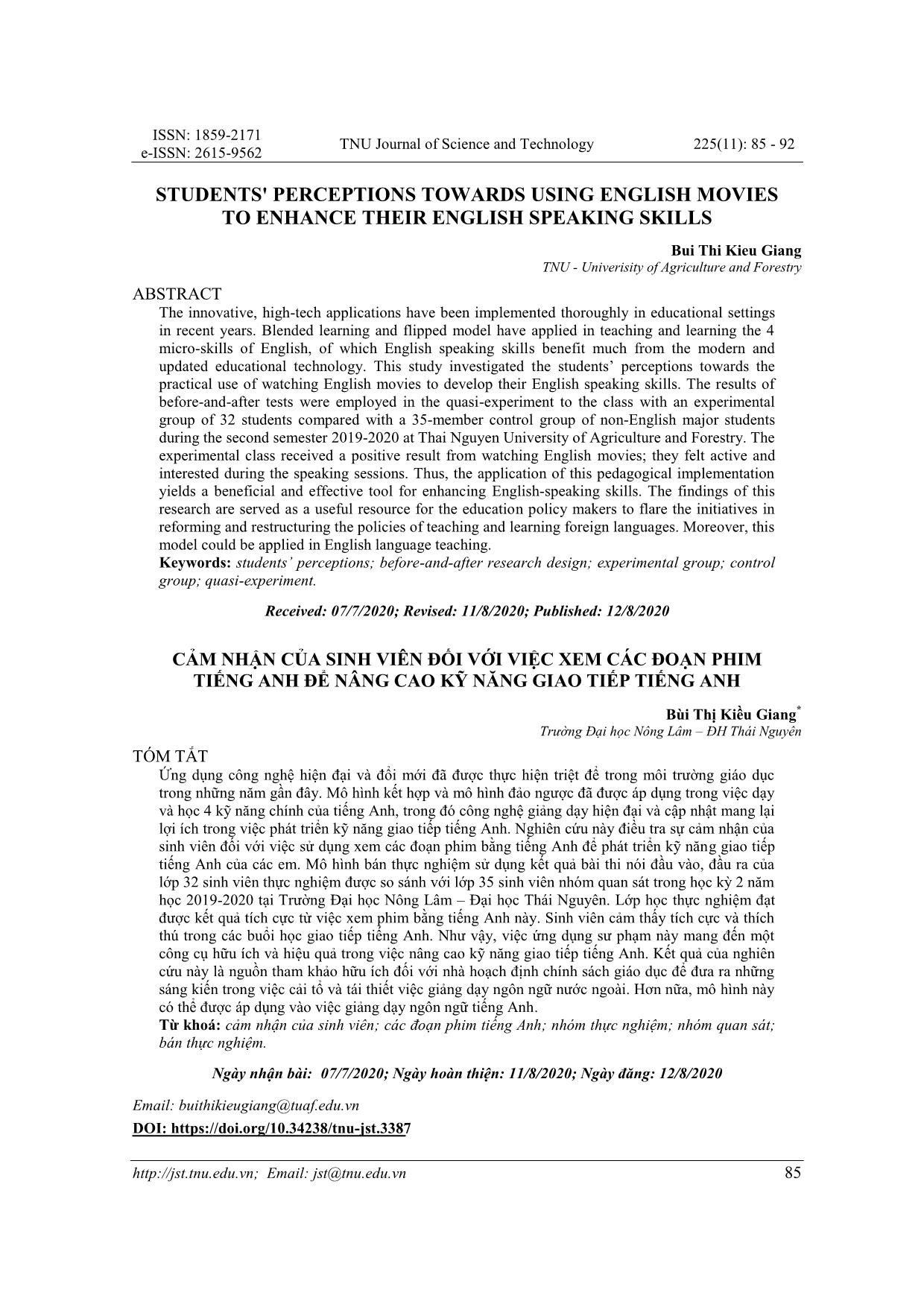
Trang 1
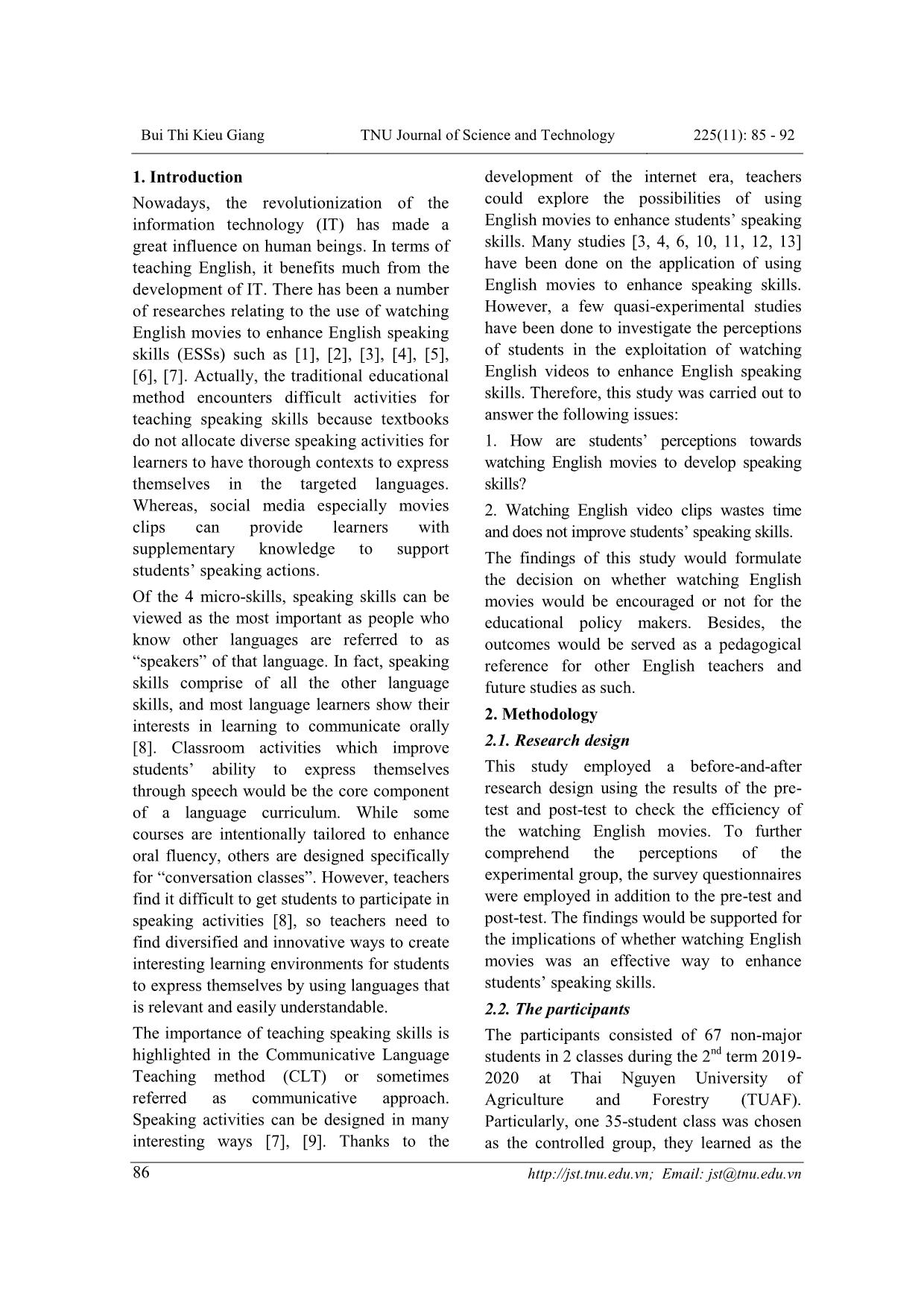
Trang 2
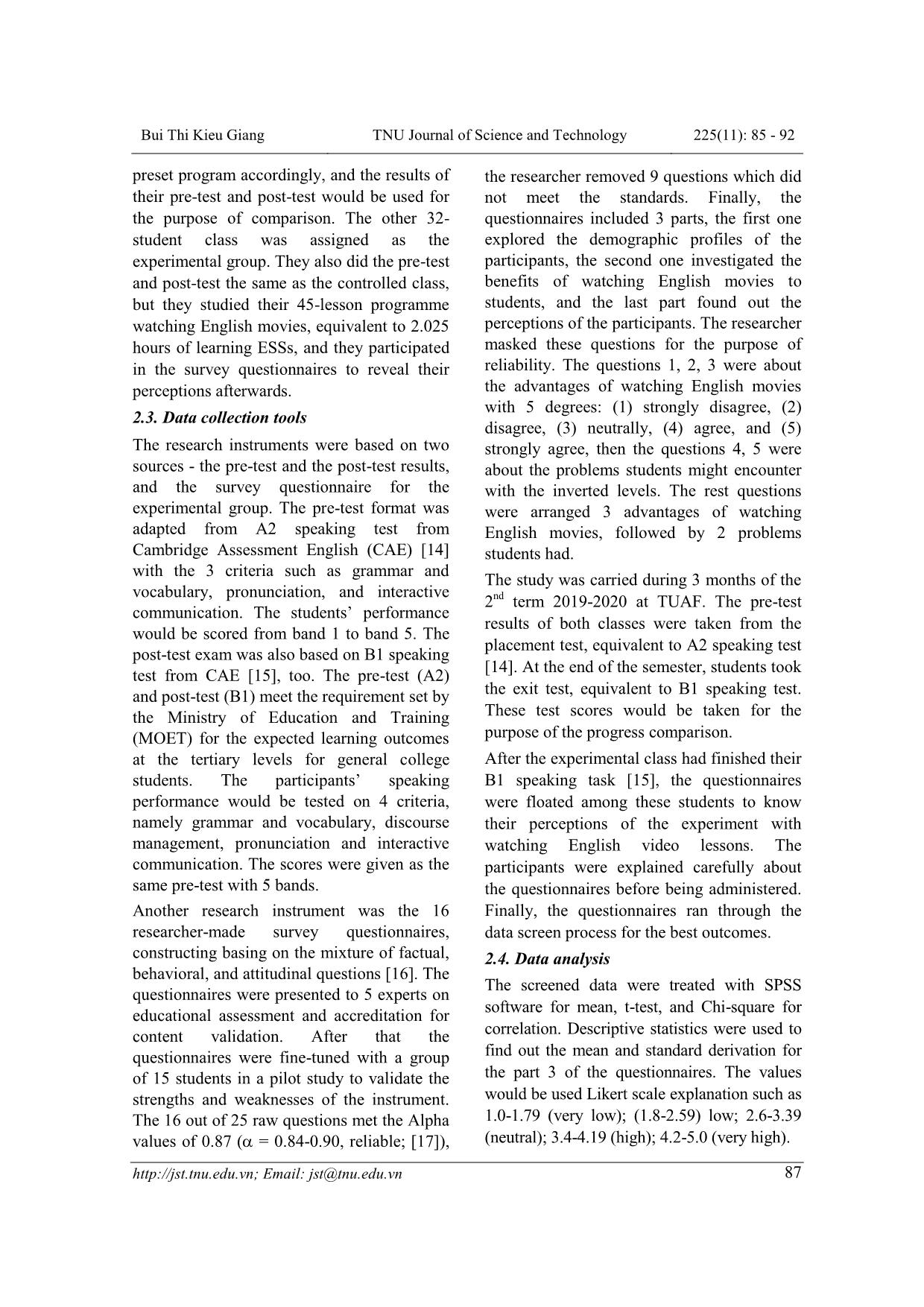
Trang 3
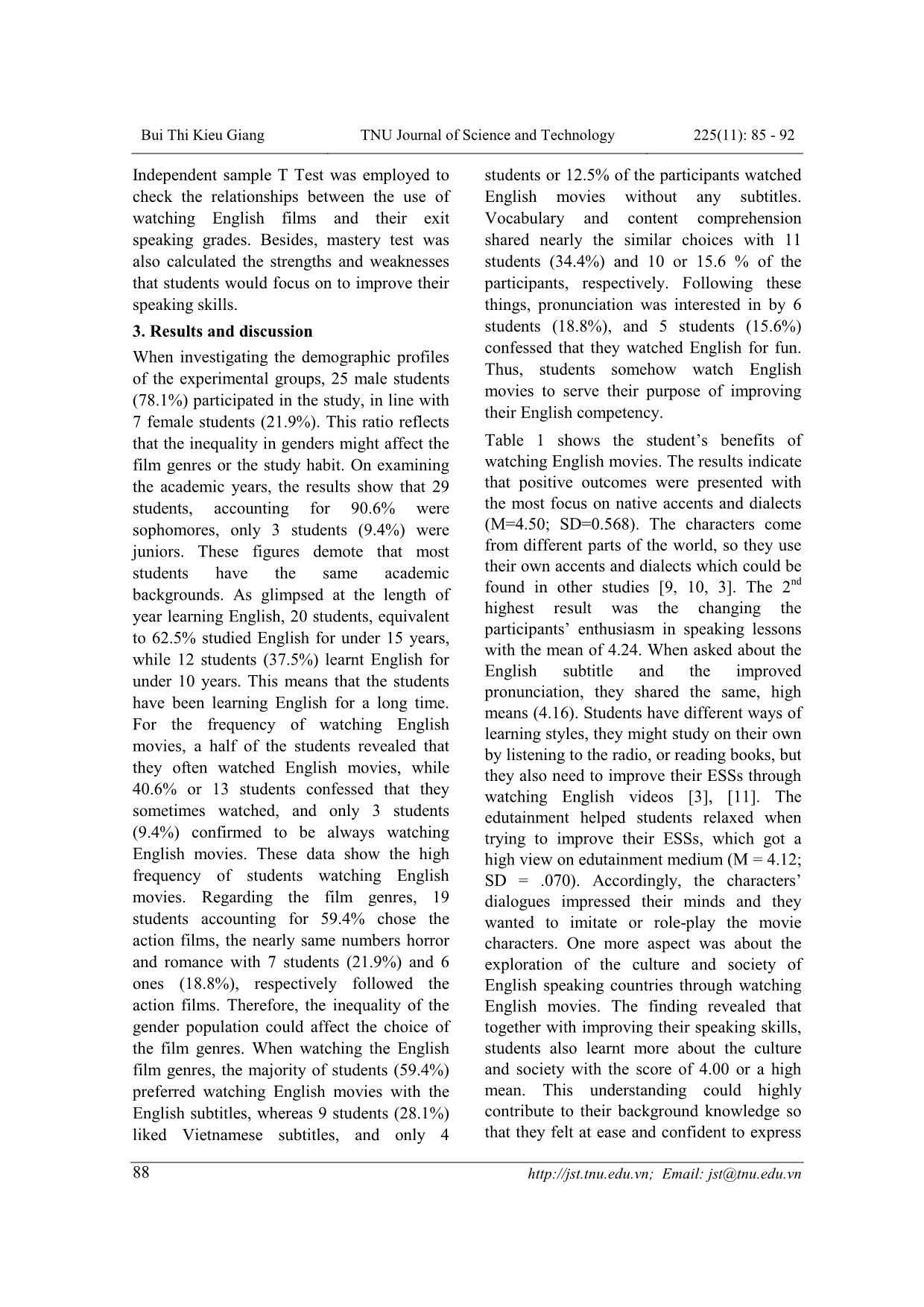
Trang 4
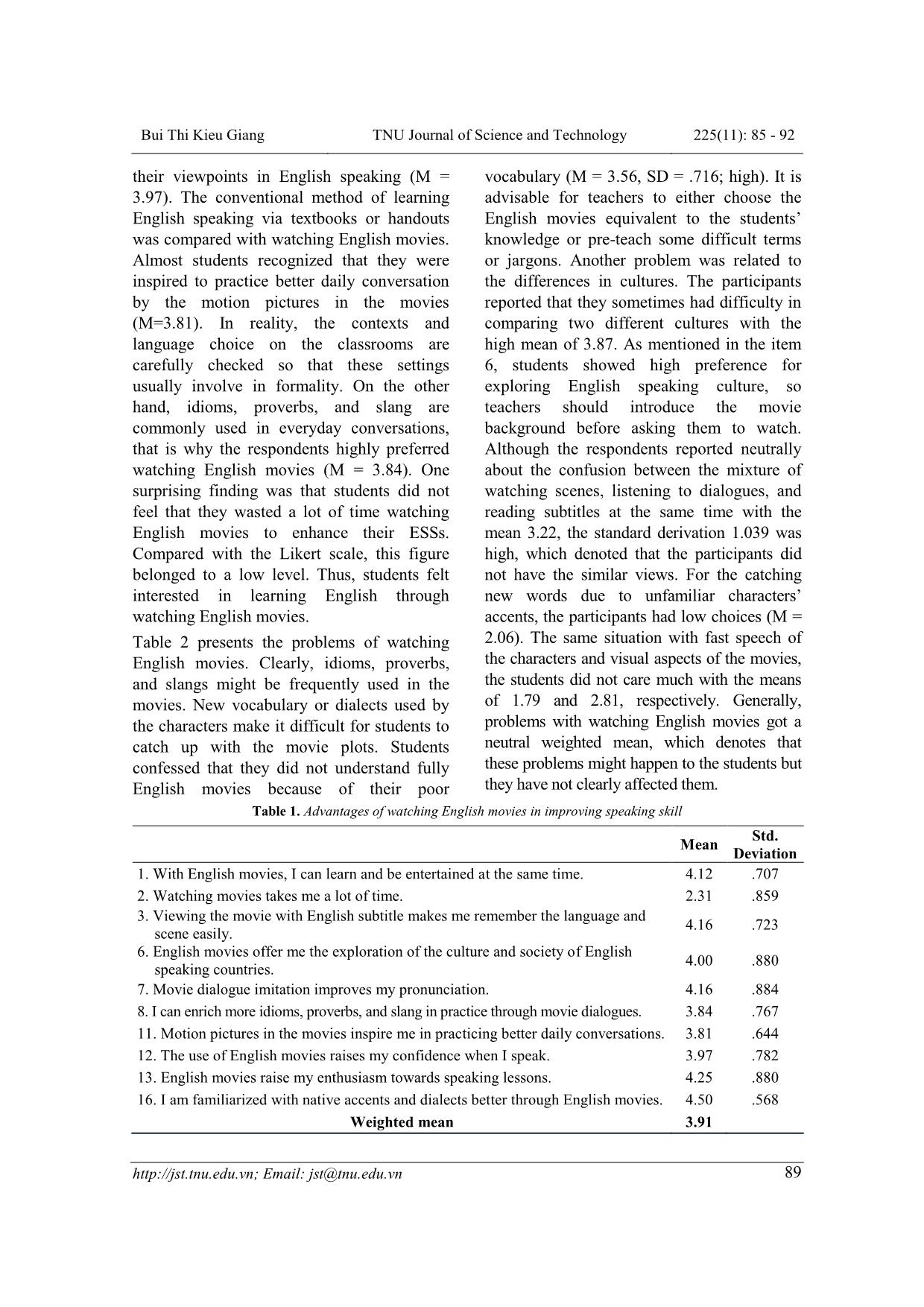
Trang 5
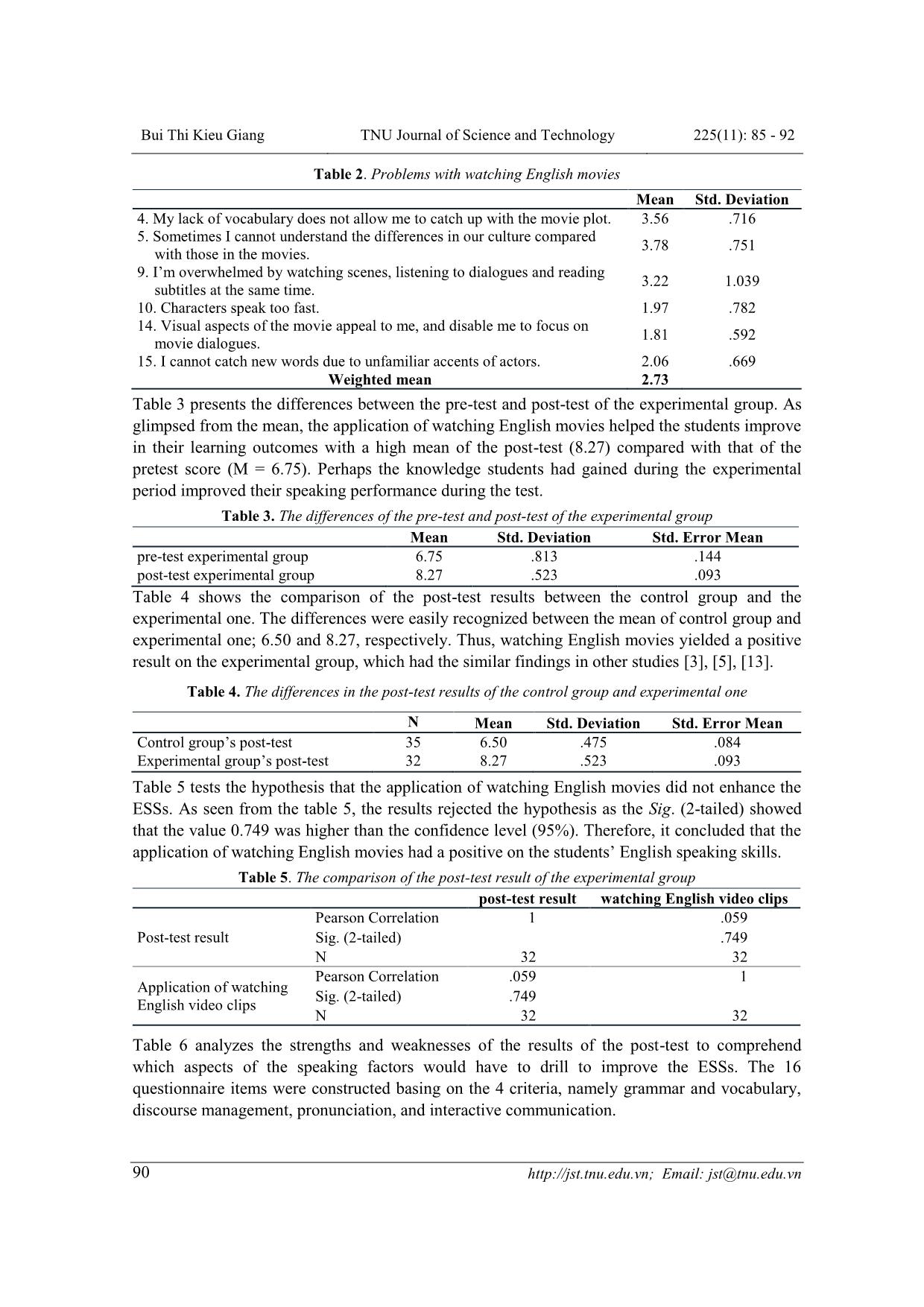
Trang 6
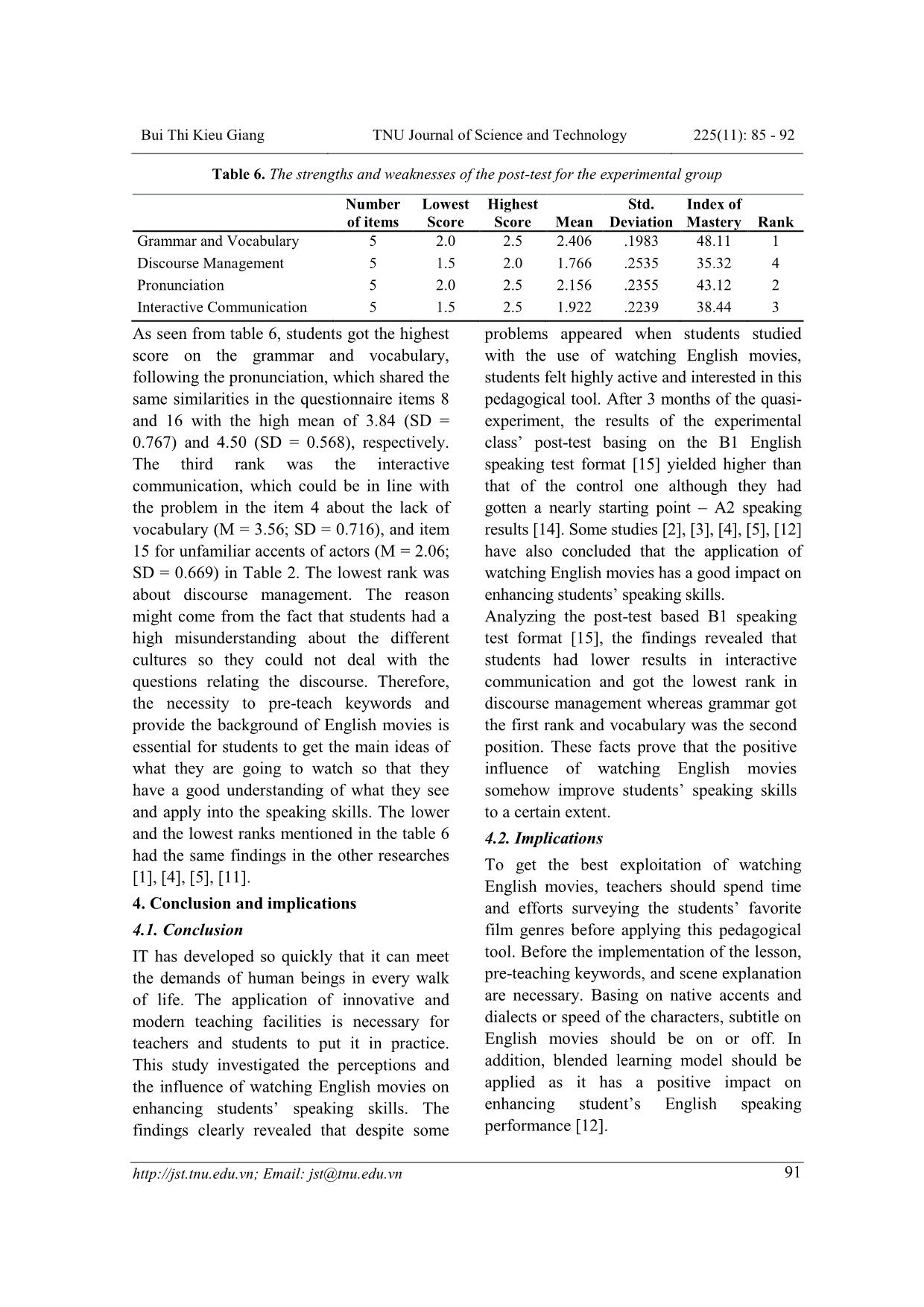
Trang 7
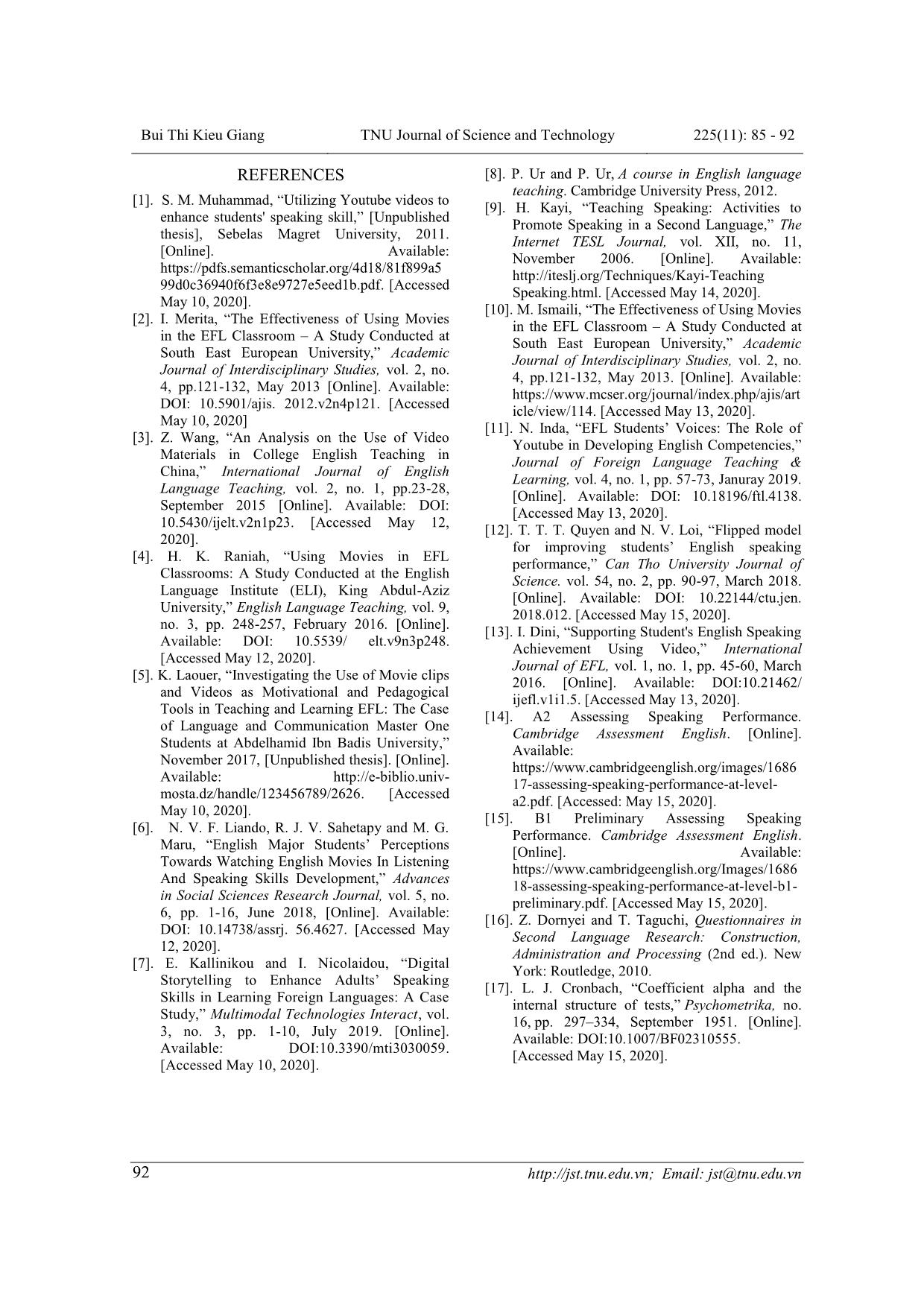
Trang 8
Tóm tắt nội dung tài liệu: Cảm nhận của sinh viên đối với việc xem các đoạn phim tiếng Anh để nâng cao kỹ năng giao tiếp tiếng Anh
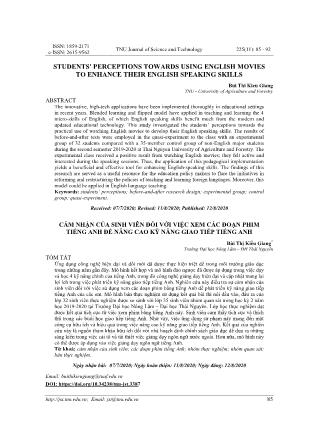
method of learning English speaking via textbooks or handouts was compared with watching English movies. Almost students recognized that they were inspired to practice better daily conversation by the motion pictures in the movies (M=3.81). In reality, the contexts and language choice on the classrooms are carefully checked so that these settings usually involve in formality. On the other hand, idioms, proverbs, and slang are commonly used in everyday conversations, that is why the respondents highly preferred watching English movies (M = 3.84). One surprising finding was that students did not feel that they wasted a lot of time watching English movies to enhance their ESSs. Compared with the Likert scale, this figure belonged to a low level. Thus, students felt interested in learning English through watching English movies. Table 2 presents the problems of watching English movies. Clearly, idioms, proverbs, and slangs might be frequently used in the movies. New vocabulary or dialects used by the characters make it difficult for students to catch up with the movie plots. Students confessed that they did not understand fully English movies because of their poor 225(11): 85 - 92 vocabulary (M = 3.56, SD = .716; high). It is advisable for teachers to either choose the English movies equivalent to the students’ knowledge or pre-teach some difficult terms or jargons. Another problem was related to the differences in cultures. The participants reported that they sometimes had difficulty in comparing two different cultures with the high mean of 3.87. As mentioned in the item 6, students showed high preference for exploring English speaking culture, so teachers should introduce the movie background before asking them to watch. Although the respondents reported neutrally about the confusion between the mixture of watching scenes, listening to dialogues, and reading subtitles at the same time with the mean 3.22, the standard derivation 1.039 was high, which denoted that the participants did not have the similar views. For the catching new words due to unfamiliar characters’ accents, the participants had low choices (M = 2.06). The same situation with fast speech of the characters and visual aspects of the movies, the students did not care much with the means of 1.79 and 2.81, respectively. Generally, problems with watching English movies got a neutral weighted mean, which denotes that these problems might happen to the students but they have not clearly affected them. Table 1. Advantages of watching English movies in improving speaking skill Mean Std. Deviation 1. With English movies, I can learn and be entertained at the same time. 4.12 .707 2. Watching movies takes me a lot of time. 2.31 .859 3. Viewing the movie with English subtitle makes me remember the language and scene easily. 4.16 .723 6. English movies offer me the exploration of the culture and society of English speaking countries. 4.00 .880 7. Movie dialogue imitation improves my pronunciation. 4.16 .884 8. I can enrich more idioms, proverbs, and slang in practice through movie dialogues. 3.84 .767 11. Motion pictures in the movies inspire me in practicing better daily conversations. 3.81 .644 12. The use of English movies raises my confidence when I speak. 3.97 .782 13. English movies raise my enthusiasm towards speaking lessons. 4.25 .880 16. I am familiarized with native accents and dialects better through English movies. 4.50 .568 Weighted mean 3.91 Bui Thi Kieu Giang TNU Journal of Science and Technology Email: jst@tnu.edu.vn 90 Table 2. Problems with watching English movies 225(11): 85 - 92 Mean Std. Deviation 4. My lack of vocabulary does not allow me to catch up with the movie plot. 3.56 .716 5. Sometimes I cannot understand the differences in our culture compared with those in the movies. 3.78 .751 9. I’m overwhelmed by watching scenes, listening to dialogues and reading subtitles at the same time. 3.22 1.039 10. Characters speak too fast. 1.97 .782 14. Visual aspects of the movie appeal to me, and disable me to focus on movie dialogues. 1.81 .592 15. I cannot catch new words due to unfamiliar accents of actors. 2.06 .669 Weighted mean 2.73 Table 3 presents the differences between the pre-test and post-test of the experimental group. As glimpsed from the mean, the application of watching English movies helped the students improve in their learning outcomes with a high mean of the post-test (8.27) compared with that of the pretest score (M = 6.75). Perhaps the knowledge students had gained during the experimental period improved their speaking performance during the test. Table 3. The differences of the pre-test and post-test of the experimental group Mean Std. Deviation Std. Error Mean pre-test experimental group 6.75 .813 .144 post-test experimental group 8.27 .523 .093 Table 4 shows the comparison of the post-test results between the control group and the experimental one. The differences were easily recognized between the mean of control group and experimental one; 6.50 and 8.27, respectively. Thus, watching English movies yielded a positive result on the experimental group, which had the similar findings in other studies [3], [5], [13]. Table 4. The differences in the post-test results of the control group and experimental one N Mean Std. Deviation Std. Error Mean Control group’s post-test 35 6.50 .475 .084 Experimental group’s post-test 32 8.27 .523 .093 Table 5 tests the hypothesis that the application of watching English movies did not enhance the ESSs. As seen from the table 5, the results rejected the hypothesis as the Sig. (2-tailed) showed that the value 0.749 was higher than the confidence level (95%). Therefore, it concluded that the application of watching English movies had a positive on the students’ English speaking skills. Table 5. The comparison of the post-test result of the experimental group post-test result watching English video clips Post-test result Pearson Correlation 1 .059 Sig. (2-tailed) .749 N 32 32 Application of watching English video clips Pearson Correlation .059 1 Sig. (2-tailed) .749 N 32 32 Table 6 analyzes the strengths and weaknesses of the results of the post-test to comprehend which aspects of the speaking factors would have to drill to improve the ESSs. The 16 questionnaire items were constructed basing on the 4 criteria, namely grammar and vocabulary, discourse management, pronunciation, and interactive communication. Bui Thi Kieu Giang TNU Journal of Science and Technology 225(11): 85 - 92 Email: jst@tnu.edu.vn 91 Table 6. The strengths and weaknesses of the post-test for the experimental group Number of items Lowest Score Highest Score Mean Std. Deviation Index of Mastery Rank Grammar and Vocabulary 5 2.0 2.5 2.406 .1983 48.11 1 Discourse Management 5 1.5 2.0 1.766 .2535 35.32 4 Pronunciation 5 2.0 2.5 2.156 .2355 43.12 2 Interactive Communication 5 1.5 2.5 1.922 .2239 38.44 3 As seen from table 6, students got the highest score on the grammar and vocabulary, following the pronunciation, which shared the same similarities in the questionnaire items 8 and 16 with the high mean of 3.84 (SD = 0.767) and 4.50 (SD = 0.568), respectively. The third rank was the interactive communication, which could be in line with the problem in the item 4 about the lack of vocabulary (M = 3.56; SD = 0.716), and item 15 for unfamiliar accents of actors (M = 2.06; SD = 0.669) in Table 2. The lowest rank was about discourse management. The reason might come from the fact that students had a high misunderstanding about the different cultures so they could not deal with the questions relating the discourse. Therefore, the necessity to pre-teach keywords and provide the background of English movies is essential for students to get the main ideas of what they are going to watch so that they have a good understanding of what they see and apply into the speaking skills. The lower and the lowest ranks mentioned in the table 6 had the same findings in the other researches [1], [4], [5], [11]. 4. Conclusion and implications 4.1. Conclusion IT has developed so quickly that it can meet the demands of human beings in every walk of life. The application of innovative and modern teaching facilities is necessary for teachers and students to put it in practice. This study investigated the perceptions and the influence of watching English movies on enhancing students’ speaking skills. The findings clearly revealed that despite some problems appeared when students studied with the use of watching English movies, students felt highly active and interested in this pedagogical tool. After 3 months of the quasi- experiment, the results of the experimental class’ post-test basing on the B1 English speaking test format [15] yielded higher than that of the control one although they had gotten a nearly starting point – A2 speaking results [14]. Some studies [2], [3], [4], [5], [12] have also concluded that the application of watching English movies has a good impact on enhancing students’ speaking skills. Analyzing the post-test based B1 speaking test format [15], the findings revealed that students had lower results in interactive communication and got the lowest rank in discourse management whereas grammar got the first rank and vocabulary was the second position. These facts prove that the positive influence of watching English movies somehow improve students’ speaking skills to a certain extent. 4.2. Implications To get the best exploitation of watching English movies, teachers should spend time and efforts surveying the students’ favorite film genres before applying this pedagogical tool. Before the implementation of the lesson, pre-teaching keywords, and scene explanation are necessary. Basing on native accents and dialects or speed of the characters, subtitle on English movies should be on or off. In addition, blended learning model should be applied as it has a positive impact on enhancing student’s English speaking performance [12]. Bui Thi Kieu Giang TNU Journal of Science and Technology 225(11): 85 - 92 Email: jst@tnu.edu.vn 92 REFERENCES [1]. S. M. Muhammad, “Utilizing Youtube videos to enhance students' speaking skill,” [Unpublished thesis], Sebelas Magret University, 2011. [Online]. Available: https://pdfs.semanticscholar.org/4d18/81f899a5 99d0c36940f6f3e8e9727e5eed1b.pdf. [Accessed May 10, 2020]. [2]. I. Merita, “The Effectiveness of Using Movies in the EFL Classroom – A Study Conducted at South East European University,” Academic Journal of Interdisciplinary Studies, vol. 2, no. 4, pp.121-132, May 2013 [Online]. Available: DOI: 10.5901/ajis. 2012.v2n4p121. [Accessed May 10, 2020] [3]. Z. Wang, “An Analysis on the Use of Video Materials in College English Teaching in China,” International Journal of English Language Teaching, vol. 2, no. 1, pp.23-28, September 2015 [Online]. Available: DOI: 10.5430/ijelt.v2n1p23. [Accessed May 12, 2020]. [4]. H. K. Raniah, “Using Movies in EFL Classrooms: A Study Conducted at the English Language Institute (ELI), King Abdul-Aziz University,” English Language Teaching, vol. 9, no. 3, pp. 248-257, February 2016. [Online]. Available: DOI: 10.5539/ elt.v9n3p248. [Accessed May 12, 2020]. [5]. K. Laouer, “Investigating the Use of Movie clips and Videos as Motivational and Pedagogical Tools in Teaching and Learning EFL: The Case of Language and Communication Master One Students at Abdelhamid Ibn Badis University,” November 2017, [Unpublished thesis]. [Online]. Available: mosta.dz/handle/123456789/2626. [Accessed May 10, 2020]. [6]. N. V. F. Liando, R. J. V. Sahetapy and M. G. Maru, “English Major Students’ Perceptions Towards Watching English Movies In Listening And Speaking Skills Development,” Advances in Social Sciences Research Journal, vol. 5, no. 6, pp. 1-16, June 2018, [Online]. Available: DOI: 10.14738/assrj. 56.4627. [Accessed May 12, 2020]. [7]. E. Kallinikou and I. Nicolaidou, “Digital Storytelling to Enhance Adults’ Speaking Skills in Learning Foreign Languages: A Case Study,” Multimodal Technologies Interact, vol. 3, no. 3, pp. 1-10, July 2019. [Online]. Available: DOI:10.3390/mti3030059. [Accessed May 10, 2020]. [8]. P. Ur and P. Ur, A course in English language teaching. Cambridge University Press, 2012. [9]. H. Kayi, “Teaching Speaking: Activities to Promote Speaking in a Second Language,” The Internet TESL Journal, vol. XII, no. 11, November 2006. [Online]. Available: Speaking.html. [Accessed May 14, 2020]. [10]. M. Ismaili, “The Effectiveness of Using Movies in the EFL Classroom – A Study Conducted at South East European University,” Academic Journal of Interdisciplinary Studies, vol. 2, no. 4, pp.121-132, May 2013. [Online]. Available: https://www.mcser.org/journal/index.php/ajis/art icle/view/114. [Accessed May 13, 2020]. [11]. N. Inda, “EFL Students’ Voices: The Role of Youtube in Developing English Competencies,” Journal of Foreign Language Teaching & Learning, vol. 4, no. 1, pp. 57-73, Januray 2019. [Online]. Available: DOI: 10.18196/ftl.4138. [Accessed May 13, 2020]. [12]. T. T. T. Quyen and N. V. Loi, “Flipped model for improving students’ English speaking performance,” Can Tho University Journal of Science. vol. 54, no. 2, pp. 90-97, March 2018. [Online]. Available: DOI: 10.22144/ctu.jen. 2018.012. [Accessed May 15, 2020]. [13]. I. Dini, “Supporting Student's English Speaking Achievement Using Video,” International Journal of EFL, vol. 1, no. 1, pp. 45-60, March 2016. [Online]. Available: DOI:10.21462/ ijefl.v1i1.5. [Accessed May 13, 2020]. [14]. A2 Assessing Speaking Performance. Cambridge Assessment English. [Online]. Available: https://www.cambridgeenglish.org/images/1686 17-assessing-speaking-performance-at-level- a2.pdf. [Accessed: May 15, 2020]. [15]. B1 Preliminary Assessing Speaking Performance. Cambridge Assessment English. [Online]. Available: https://www.cambridgeenglish.org/Images/1686 18-assessing-speaking-performance-at-level-b1- preliminary.pdf. [Accessed May 15, 2020]. [16]. Z. Dornyei and T. Taguchi, Questionnaires in Second Language Research: Construction, Administration and Processing (2nd ed.). New York: Routledge, 2010. [17]. L. J. Cronbach, “Coefficient alpha and the internal structure of tests,” Psychometrika, no. 16, pp. 297–334, September 1951. [Online]. Available: DOI:10.1007/BF02310555. [Accessed May 15, 2020].
File đính kèm:
 cam_nhan_cua_sinh_vien_doi_voi_viec_xem_cac_doan_phim_tieng.pdf
cam_nhan_cua_sinh_vien_doi_voi_viec_xem_cac_doan_phim_tieng.pdf

